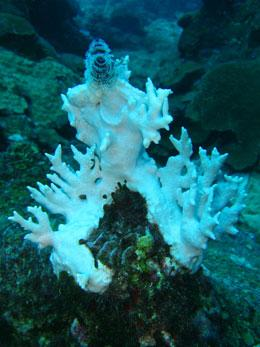Warmer oceans taking toll on world’s coral reefs
WASHINGTON — Global warming took a toll on coral reefs in 2010, endangering one of the world’s key ecosystems that benefit people in countless ways. Coral reefs are habitat for almost 100,000 known marine species, including about 40 percent of all fish species. They feed millions of people, protect coasts by absorbing wave energy, and shelter creatures that could become sources of medicine for treating cancer, HIV/AIDS and other diseases. National Oceanic and Atmospheric Administration satellite data show that 2010, the warmest on record, was hard on corals. Warmer than normal temperatures stressed tropical corals, causing them to bleach — expelling the algae that live in their tissue, giving them color and nourishment. Some 75 percent of the world’s reefs are threatened by climate change, overfishing and pollution, according to a new assessment from the World Resources Institute and other conservation organizations. The number increased dramatically from the group’s last assessment in 1998. “It will take a Herculean effort to reverse the current trajectory and leave healthy ocean ecosystems to our children and grandchildren,” said Jane Lubchenco, the marine scientist who heads NOAA. “How the world rises to this challenge is a reflection of our commitment to one another and to the natural world that gives us sustenance, wisdom, and a reflection of our souls.” … NOAA’s satellite data on ocean heat showed that bleaching is occurring in all regions and becoming more frequent. Extreme bleaching kills corals because they can’t survive without the nourishment the algae provide. Less intense bleaching can weaken corals, reduce their growth and reproductive ability, and make them more vulnerable to disease. Mark Eakin, a University of Miami-trained oceanographer who coordinates NOAA’s Coral Reef Watch satellite program, said that 2010 was only the second time on record that bleaching occurred globally. The first global bleaching, from 1997 to 1999, came when an exceedingly strong El Niño — a periodic warming of ocean surface temperatures in the tropical Pacific — was followed by an especially strong version of its opposite counterpart, La Niña. About 15 percent of the world’s corals died then. “Fast forward to 2010,” Eakin said. This time, El Niño and the La Niña that followed weren’t nearly as strong. “The problem that we’re seeing is, as the oceans keep warming on a year to year basis, it doesn’t take as big or as unusual conditions to result in this sort of event.” The bleaching from last year in many places was the worst since 1998. In the warmest months, bleaching hit the Pacific, the Indian Ocean, Southeast Asia and the southern Caribbean. … Andrew Baird, a scientist at the Australian Research Council’s Coral Reef Studies center, said he just returned from Indonesia’s Aceh province, where nearly 100 percent of corals died at most sites. He said the total loss of coral cover could range from 50 percent to 80 percent. “This is as bad as I have ever seen,” Baird said. …
